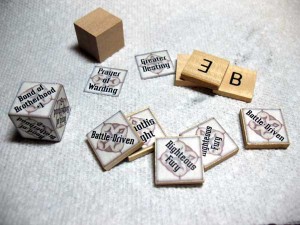Protectorate of Menoth Tokens, Take 2
I’ve never been a big fan of GF9’s tokens, and Privateer Press’ don’t work for me either. Both companies’ designs have some shortcomings that caused me to stay away from their products. At first I used Youngwolf7’s tokens, but by the time I picked up the Legion of Everblight I had started making my own.

Now that the Forces of Warmachine: Protectorate of Menoth book has been released I finally sat down between applying coats of primer to some miniatures to put together some tokens for my Protectorate force. I still had my set from MkI but enough abilities were renamed for me to decide to redesign a new set instead of using Youngwolf7’s design.
I did a little editing to the graphic used on the Privateer Press gallery page to create the background for my tokens, and added some text layers to create what’s pictured above. I used .75″ cubes or .75″ faux scrabble tiles I picked up at the local craft store to give the tokens some width and heft. They can usually be found in the woodworking and scrapbooking departments respectively. Mosaic tiles are another option, but those are concave and/or have an irregular surface, making these better surfaces for gluing.
Since I started this post talking about the issues I have with the PP and GF9’s offerings, I suppose I should go into a little more detail on what I think makes good tokens.
Ease of Handling
I mentioned the materials I used to add some width to my tokens. One of the biggest complaints I heard against the first generation of Privateer Press’s hordes tokens were the odd conical-shuriken-style fury counters, and the paper-thin spell tokens weren’t much better. GF9’s were marginally better, but I heard complaints from some of the local players about those designs as well.
Readability/Recognition
Whoa boy, this one is a biggie, and one I think I’m going to be disagreed with about. When I put a token down on the table, I and any opponent that see it should be able to immediately know what it represents. If there’s any confusion or wondering what a token represents, it defeats the purpose of using tokens in the first place.
This is the biggest reason I am not a fan of the new PP and GF9 tokens. Since they have a fixed set of symbols on them, every player uses them to represent different spells and effects, even for the same caster. For most casters, their spells don’t even have appropriate matching symbols.
GF9’s first generation of tokens were much better. Each caster had their own set, with tokens for all of their spells. The down side was that they used small tokens and tiny fonts, making them almost unreadable at a distance and almost as poorly designed as the symbol-based sets.
Size and Footprint
Tokens need to take up as little space as possible and still be able to convey whatever they are representing. The original GF9 tokens tried to accomplish this but wound up using a design for their spell effects that were too small to be readable. Their second attempt keeps the small design, but doesn’t need the real estate to just display a symbol.
Then there’s GF9’s Warclaws. I don’t know what to say – these are perhaps the silliest, most unwieldy, and ultimately worst Warmachine/Hordes token design to date. I don’t really know how to describe how silly these tokens are. They pretty much compile all that has been bad about the previous iterations into one nice steamy pile for what I assume is some sort of convenience in obtaining maximum crap at once.
So far the .75″ square surface area has been plenty for me to write out the name of any of the spell effects necessary for either of my forces. It’s readable from a distance on the tabletop and does what it needs to without being obtrusive.
Cost
Here’s the final one, and the kicker. If someone’s biggest concern is putting the least amount of work into picking up something that will work for them, a set of Warcogs or Warclaws are around $12 from GF9. They’re not pretty, they’re not the best designs in the world, but since you can re-use the tokens for any warcaster, it’s a single expenditure and you’ve got what you need.
For me, an hour of assembly time and about $5 has purchased all the tokens I’m ever going to need. When future books come out, it will take about 5 minutes to update my set with no additional monetary cost. For a little bit more work and less monetary cost, I get what is in my opinion a superior product.
Great looking tokens. I especially like the Bond of Brotherhood cube, fantastic idea.
Thanks. I do the same with multi-ability unit/models where each ability’s use is mutually exclusive of the others. For example, the Choir’s hymns, Aiyana’s spells, etc. That way I only have one physical token to keep track of.